Filipino cuisine
culinary traditions of the Philippines
Filipino cuisine has developed from the different cultures that shaped its history; it is like other Southeast Asian cuisines but with heavy Spanish influence. Some ingredients from Mexico, such as corn, tomato and chili, have also found their way to the Philippines.
| Cuisines of Asia and Oceania Australian • Burmese • Cambodian • Chinese • Filipino • Indonesian • Japanese • Korean • Malaysian, Singaporean and Bruneian • Middle Eastern • South Asian • Thai • Vietnamese |
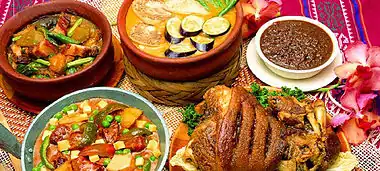
Though its cuisine is not as renowned as that of several of its neighbours, including Thailand and Vietnam, Filipino cooking is distinct in being possibly the least spicy of all Southeast Asian cuisines.
Don't make the mistake of thinking that Filipino food is bland, though. It is just that instead of spices, Filipino food depends more on garlic, onions and ginger to add flavor to dishes. Painstaking preparation and prolonged cooking time is also a characteristic of most Filipino dishes, and when done properly is often what brings out the flavor of the food, as opposed to a healthy dose of spices.
With over 7,500 islands, the cuisine of the Philippines is rather a mish-mash of hundreds of local, regional, and ethnic cuisines, and without any qualifiers, you would often think of ubiquitous dishes such as adobo, sinigang, lechon, and Filipino-Chinese dishes.
Understand
|
Cooking terms
What's in your menu?
|
Kamayan means eating by hand. Some Filipinos who were born and raised in rural provinces still eat with their hands, mostly at their homes during mealtimes. They would often say that kamayan makes food taste better. Wash your hands clean before attempting this to avoid illnesses. Almost all Filipinos in the urban areas though use spoons, forks and knives. Eating with hands in public is not uncommon but can be considered rude if you're at a mid-range or upscale restaurant.
To experience how the Filipinos eat in a budget way, carinderias (eateries) and turo-turo (literally "point-point", which actually means you point at the food you want to eat in the buffet table) are some of the options. Mains cost less than ₱50. Carinderias serve food cooked earlier and it may not always be the safest of options.
As with the rest of Southeast Asia, rice is the staple food of the Philippines. Some areas in the Visayas prefer corn but elsewhere Filipinos would generally have rice for breakfast, lunch and dinner. Uncooked rice usually comes in 50 kilograms (110 lb) sacks but can be bought by the kilogram at the wet market or at neighborhood rice dealers. Single servings of rice are readily available at fast food restaurants or eateries.
Filipino diet
The word diet is non-existent in the vocabulary of Filipinos or has never existed, as mentioned before they are laid-back people, they love to eat as much as they can as if there is no tomorrow. They spend most of their money on food, and a Filipino teenager might at least enter a fast food chain two or three times a week, during fiestas in a city, town, barangay, purok or subdivision Filipinos would have big parties and it would last from noon to midnight when some of the people would end up being drunk, you can ask if you can join a fiesta in a home and some might welcome you as this is a tradition.
While you're visiting the Philippines is the best time to cheat on your diet and eat to your heart's content. The Filipino diet is sometimes a lot more similar to the West than the rest of the East, with Filipinos eating fewer fruits and vegetables, more oil, meat and sugar than people in neighboring nations; many Filipinos aren't health-conscious. Cancer and heart-related diseases are the leading causes of death here. However if you visit rural areas, they use more fresh produce (vegetables, fruits, grains, etc.) and less meat and practice old Filipino medicine. In coastal areas, fish and many sorts of seafood are usually served and eaten.
Regional and ethnic cuisines
Filipino cuisine varies a lot by region, by province, by island, and ethnic group, and while you can get around with the usual Filipino breakfast fare and the two contenders for the Philippine national dish, adobo and sinigang, there are over hundreds of cuisines scattered throughout the archipelago. The most prominent of Filipino cuisines are Tagalog, Visayan, Ilocano, Kapampangan, Bicolano, Moro and Filipino-Chinese (and derivatives), but other regions and ethnic groups also have their own dishes, often unknown to visitors.
- Ilocano: Heavy on fresh vegetables and seafood, they are most known for pinakbet or dinengdeng (vegetable dish with minced pork or fish paste), but are also known for rather obscure exotica like weaver ant larvae (abuos) and "jumping salad" made from tiny live shrimp.
- Igorot or Cordilleran: The cuisine of the Cordilleran peoples (also called the "Igorot") are relatively obscure, but they usually eat roasted meat with a generous serving of local spices. Igorots also eat dog, while illegal on most of the country, is given a special exception as a food served on indigenous religious ceremonies.
- Kapampangan: The cuisine of the Kapampangan people, it is known for longganisa (pork sausage), tocino (cured pork), and sisig (a dish made from pork cheeks and offal)
- Tagalog: The cuisine of the Katagalugan (Bulacan, Nueva Ecija, Metro Manila, CALABARZON), it is heavy on rice, meat, and desserts. Bulacan is known for its chicharon (pork rinds), steamed rice, and rice cakes (kakanin). The cuisine of Batangas, for its coastal location, is heavy on fish, but is also known for bopis (pork lung and heart sautéed in chilis, tomatoes, and onions), and lomi. There is also a local variety of coffee called kapeng barako which many visitors find quite good.
- Bicolano: Characterized by the use of coconut milk and chili, it is the spiciest among the Philippine cuisines. It is known for Bicol Express/sinilihan (pork stew slow-cooked in coconut milk, green peppers, and onions), and laing/pinangat (pork or fish stew wrapped in taro leaves)
- Visayan: Widely varies by island and province, but the most notable dishes are La Paz Batchoy of Iloilo City, inasal and inato chicken of Bacolod, and lechon of Cebu.
- Mindanaoan: Mindanaoan cuisine has much commonality with the cuisines of Indonesia and Malaysia than those of the Philippines, and can be said to be what Filipino food looked like before the Spanish colonization. Distinctive ingredients of Mindanaoan food include turmeric, cilantro, lemongrass and chilis.
- Moro: Heavy in spices and coconut, but uses only halal ingredients. Famous Moro dishes include satti (satay), ginataang manok, rendang (a Maranao specialty, but much sweeter than the original Minangkabau recipe) and piyanggang manok (a Tausug marinated chicken dish). Sambal sauce is a common base for Moro dishes.
Meal times
Meal times are much influenced by Hispanic traditions. An average Filipino eats four meals a day, but at earlier times; thus, the typical meal schedule is closer to that in the United States.
- Breakfast (almusal/agahan/pamahaw) is traditionally eaten between 7 and 11AM (or earlier). A typical Filipino breakfast meal can be as light as coffee and salted bread buns (pandesal), or full as any of the silog breakfasts — composed of fried rice (sinangag), egg — scrambled or fried ("sunny side up"), and a main — commonly tapa (smoked beef), tocino (cured pork), or longganisa (pork sausage). Other common breakfast items are lugaw (congee) and champorado (chocolate rice porridge). Fast food restaurants provide both Filipino and Western breakfast options.
- Lunch runs between 11AM and 3PM, and traditionally involves a siesta, though it's no longer as common in the past. Children are often asked to nap after having lunch, especially in conservative Filipino families.
- There is also a traditional afternoon snack (merienda) which runs at the late afternoon, usually 3PM through 6PM.
- Dinner starts at 6PM and can be light as bread and coffee, or heavy with a multi-course meal.
Ingredients
- Fruits like calamansi (small limes, or calamondins), guavas (bayabas), mangoes (mangga), pineapple (pinya), plantain (cooking bananas or saging na saba) also feature heavily in Filipino cuisine, and provide the tropical flavor of various dishes. Calamansi is often combined with soy sauce for the right combination of sourness and saltiness.
- Most Filipino dishes are heavy on meat, like beef (baka), chicken (manok), and pork (baboy), and occasionally goat (kambing). Offal is also commonly eaten by Filipinos, and forms the main ingredient of dishes like bopis, dinuguan, La Paz batchoy and sisig and street food like adidas, Betamax or dugo, and isaw. A few regions have exotic meat dishes, like dog in the Cordilleras, and crocodile in Palawan.
- Rice is the archetypical Filipino staple food, it is not only steamed or fried and eaten plain with other dishes, but also used to create many types of rice cakes or kakanin, including puto (rice cupcakes) and bibingka (rice pancakes served in banana leaf strips).
- Seafood - As an island nation, there's no shortage of fish and shellfish dishes, especially in coastal or island provinces. The Ilocos Region is known for fish or shrimp pastes (bagoong), Batangas for tawilis (a species of sardine endemic to Taal Lake), Roxas City for its variety of seafood dishes, and Zamboanga City for their sardines.
- Vegetables are usually complements in main dishes, and are sautéed, steamed, or stir-fried. Kangkong (water spinach)
- Vinegar (suka) is also a common ingredient in dishes like adobo sa suka, a variant of the famous adobo.
The Chinese introduced other ingredients such as noodles (usually pansit), soy (soya, used in soy sauce (toyo) and tofu (tokwa), and other vegetables, while the Spaniards brought in New World fruits and vegetables, spices, bread and pastries, and cheese.
Rice is generally the staple throughout most of the country, but some regions (e.g. Cebu, Cagayan Valley) have corn (mais) instead.
Dishes
Ulam (main dishes)
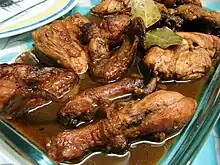
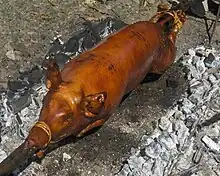
- Adobo - Chicken, pork or both served in a garlicky stew with vinegar and soy sauce as a base. It is arguably the national dish of the Philippines.
- Bicol Express (or sinilihan) — Named after the eponymous passenger train and one of the famous Bicol dishes, it is pork or pig intestine slow-cooked in coconut milk, vinegar and some spices.
- Bopis - Originating from Batangas, it is chopped pig heart and lungs, usually served spicy.
- Burong talangka - A Filipino version of caviar, using the eggs of talangka or small crabs.
- Calamares - fried shrimp/squid wrapped in breading.
- Camaron rebusado - the Filipino version of tempura.
- Chicken curry - A lot different from other curries because it isn't spicy unlike other curries. Aside from chicken, crab curry and other varieties are also available.
- Daing na bangus - Fried dried milkfish, usually served for breakfast with garlic fried rice and fried egg.
- Dinuguan - A dark stew made from pig blood and innards. Usually served with a big green chili and paired with puto (rice cakes).
- Kare-kare - A stew of vegetables and meat simmered for hours in peanut sauce. It is usually made from ox tripe and tail and eaten with shrimp paste (bagoong). There is also a seafood version, with crabs, squid and shrimp used instead of beef.
- Laing - Pronounced LAH-eeng, it is taro leaves cooked in coconut milk.
- Lechon - Roasted suckling pig, usually served in large occasions like fiestas, Christmas dinner (Nochebuena) and the New Year feast (Medianoche). Two major regional variations exist: the Visayan lechon (with the Cebu variant the most notable) which is stuffed with herbs, and the Manila lechon (with the variant served in Quezon City's La Loma district being the most known) which is served with a sauce made from the pig's liver. Chicken and beef variants are available as well.
- Lechon de leche - A version of lechon made from slow roasted piglet. The crispy skin is delicious and is often the first part that is consumed.
- Lengua - roasted beef tongue marinated in savory sauce.
- Nilaga - Literally means "boiled", it is usually beef (which in certain places is served with its marrow (bulalo)), pork or chicken.
- Paksiw - fish or vegetables cooked with vinegar, ginger, garlic and chili picante.
- Pinakbet - a traditional Ilocano dish of mixed vegetables usually containing cut tomatoes, minced pork, lady finger, eggplant, etc.
- Sinigang - One of the most famous Filipino dishes (and a candidate for the national dish of the Philippines), it is sour broth served with meat or seafood (usually beef, pork, fish, and shrimp) and vegetables like string beans, taro, radish and tomatoes. The sour taste usually comes from tamarind (sampalok), but guavas, mangoes and other acidic fruits can be used for the same effect.
- Tinola - A dish notably mentioned in the novel Noli me tangere by Jose Rizal, it is chicken in ginger soup, but can be also made with fish, seafood, or pork. It is closely related to ginataang manok or binakol.
Pansit/pancit (noodles)
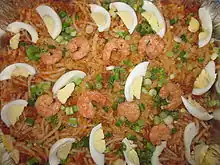
Pancit — also spelled as pansit — or noodles, an influence from Chinese cuisine and believed to give long life because of its length, is often eaten in celebrations such as birthdays and New Year. Below listed are some popular Filipino noodle dishes:
- Pancit batchoy/La Paz Batchoy - a noodle soup usually made from pork entrails, crushed crunchy fried pork rinds, shrimp, vegetable, chicken stock, chicken, beef and especially noodles.
- Pancit bihon - sautéed noodles along with vegetables, pork and shrimp.
- Pancit molo - a Filipino version of wonton soup, however without the noodles.
- Pancit palabok - boiled noodles, topped with achuete (annatto seeds), shrimp, and crushed crunchy fried pork.
- Pancit habhab - Stir-fried rice noodles, served in a banana leaf. Eaten without utensils by placing directly to the mouth. It is the signature noodle dish of Lucban, Quezon.
- Pancit Bato — It is raw noodles named after the town of Bato in Camarines Sur. It is cooked either with or without soup.
Breakfast
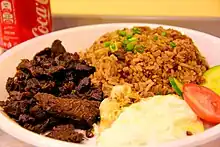
The usual Filipino breakfast meal is silog or pankaplog, which is equivalent to the typical American breakfast of egg, bacon and pancakes. Silog is a contraction of the words sinangag (fried rice) and itlog (egg), while pankaplog stands for pandesal, kape and itlog (bread, coffee and egg). Silog is not served on their own, but paired with a meat dish like adobo (as adosilog), corned beef (as cornsilog), longganisa (longsilog), tapa (tapsilog, or simply tapsi), and tocino (tosilog).
Silog is usually served in eateries on morning hours, or in dedicated establishments called tapsilugan (or tapsihan), which may be open all day or only in the morning. Fast food restaurants like Jollibee and McDonald's also serve silog between 7AM and 11AM.
Condiments and salads
- Achara - Pickled papaya salad, with origins in South Indian cuisine.
- Banana ketchup - During World War II, stocks of tomato ketchup ran out and people started complaining. So due to the high production of bananas, Filipinos thought of using banana instead of tomato. Don't worry: it doesn't taste like banana at all; it is kind of like sweet and sour ketchup. Try it with chicken, pork chops or spaghetti.
- Bagoong (shrimp paste) - Shrimp paste is popular throughout Southeast Asia. Some people get allergies from shrimp paste, but they still consume it despite the itchy skin problems it causes. Sometimes, fish is used instead.
- Patis - Fish sauce.
- Radish salad - Salad of radish, onion and sugar, enjoyed with fish.
Snacks
Kanin at kakanin (rice and rice cakes)
Kanin means rice in Tagalog while kakanin means rice cakes.
- Sinangag is fried garlic rice, often mixed with vegetables, dried shrimps, dried fish strips, hotdogs or chorizos.
- Bibingka - rice cake with cheese and salted egg, it originates from Indian cuisine.
- Puto - Soft white rice muffins.
Other kinds include biko, kutsinta, pichi-pichi, sapin-sapin, etc. The towns of Calasiao in Pangasinan and Biñan, Laguna are famous for their puto.
Bread and pastries
- Pandesal - Spanish for "salt bread", they are small buns usually made fresh in the morning, an alternative to rice for breakfast. They are usually eaten with a cup of coffee. Some people prefer to dip their pandesal in coffee.
- Chicharon - Pork rinds, crunchy snacks made from deep-fried pig skin. If you don't eat pork or have dietary restrictions there is chicken chicharon and sometimes fish chicharon.
Fruits and desserts
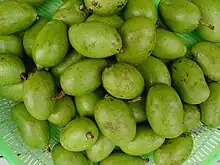
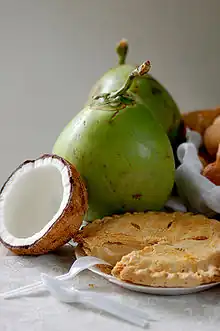
Tropical fruits abound in the Philippines. Most of the countryside produce finds its way to the metro areas and can be easily bought in supermarkets, such as:
Fruits
- Coconut - Although it's familiar, you should try the coconut of the Philippines, the country is the largest exporter of coconuts in the world.
- Durian - smells like hell but supposedly tastes of heaven, most common in Davao but can usually also be bought in some supermarkets in Manila.
- Green mangoes, ripe mangoes', dried mangoes - Don't leave Philippines without trying green Indian mangoes with bagoong (shrimp paste), tasting ripe mangoes and buying dried mangoes as a pasalubong.
Sweet treats
- Banana chips - Unlike the ones eaten in India, the Filipino version is a lot thicker and sweeter; try dipping it in ice cream.
- Buko pie - Pie with scraped coconut as filling.
- Cassava cake
- Egg pie - Pie with sweet, flan like filling
- Halo-halo - Halo-halo means combinations in Filipino, is another refreshing dessert which is a mix of sweetened beans and fruits, such as sweetened bananas, red and white beans, sago, crushed ice and milk and topped off with leche flan and ube jam and/or ice cream.
- Ice scramble (iskrambol) - Crushed ice with condensed milk.
- Mais con hielo/yelo - A dessert of fresh sweet corn served in a glass mixed with crushed ice and milk.
- Pili nut candy - a sweetend kernel of a pili nut often a pasalubong from Bicol Region.
- Sampaloc candy - salted and sweetened tamarind fruit.
- Turon' - Saba bananas in wrappers and fried and then topped with condensed milk or sugar.
- Turron - From Europe, a bar of cashew nuts with a white wafer.
Cuisines
Western cuisine
- See also: Western food in Asia
Spanish, Portuguese, Mexicans, Americans and other European and Mediterranean peoples introduced their cuisine to the locals and just like they did to the Chinese, they embraced it. While the Spanish occupied the Philippines, connections of the Mexicans and the Aztecs with the Filipinos started in the Manila-Acapulco trade, where those people introduced to each other their native cuisine. American influence came during the American colonization.
- Arroz caldo - Rice porridge, topped with egg, chicken liver and ground chicharon.
- Arroz de Valenciana - Filipino style paella.
- Biscocho - Sweet biscuits.
- Caldereta - Pork or beef tomato soup with sausages and vegetables.
- Champorado - Chocolate rice porridge. Introduced by the Mexicans but with rice added. It is kind of like hot chocolate but with rice on it.
- Empanada - Stuffed pastry.
- Ensaymada - Sweet bread topped with cheese and butter.
- Leche flan - Creme brulee (custard pudding).
- Menudo - Pork stew.
- Spaghetti - Possibly brought to the Philippines by the American-Italians during the American colonization, this is a must try for pasta lovers not because they love it, but because it is so different from the Italian spaghetti. Unlike the Italian version, Filipino spaghetti is sweet, with its ingredients including sugar, banana catsup and condensed milk. The Filipinos are meat lovers who obsessively add meat to their spaghetti, including hotdog, ham and corned beef or ground meat.
Filipino-Chinese cuisine
The Filipinos and Chinese traded with each other in the early times, then the Chinese finally began settling in the Philippines and introduced their cuisine and culture, the Filipinos embraced the Chinese heritage and started adapting it in their lives including food. Most of the dishes found below are served in Manila Chinatown and Filipino-Chinese fast food chains and eateries.
- Bihon (米粉) - Stir-fried noodles with either prawns or pork in it.
- Hopia (好餅) - a sweet pastry dough with a filling inside it either yam, mung beans etc.
- Kiampong (鹹飯) - Fried rice.
- Tikoy (年糕/甜粿) - Sticky rice cake, often eaten in New Year's Eve and Chinese New Year, believed that it would keep family ties strong.
- Lumpia (潤餅) - Spring rolls.
- Taho (豆花) - Fresh tofu with brown sugar and vanilla syrup and pearl sago (pearl tapioca)
- Siomai (燒賣) - Dim sum.
- Siopao (燒包) - Steamed buns with meat filling inside it.
- Mami (肉麵) - Noodle soup.
- Lugaw (粥) - Congee made from coconut milk and glutinous rice.
Fast food
America's influence is palpable in the Philippines, and you'll be hard pressed to find a mall without the requisite McDonalds, KFC, Pizza Hut, and even Taco Bell. Filipino fast food chains that capture the essence of Filipino food compete strongly for Filipino taste buds, however, and they may be a safe place for the tourist to try the local fare. The following are a list of local fast food chains that have locations around the country.
- Chowking. The Filipino version of Chinese food, also owned by Jollibee. For good sampling of their food, try the Lauriats, which feature a viand (beef, pork, chicken), rice, pancit (fried noodles with meat and veggies), siomai (dumplings), and buchi (a sweet rice ball covered with a sesame based coating. US$2-3 per serving.
- Goldilocks. The place to go for your baked treats and sweets like mamon (a spongy round cake), polvoron (a tightly packed powdery treat) ensaymada (bread baked with cheese and sugar), and a host of other delicacies for those with a sweet tooth.
- Goto King. This is where you go to get the localized version of congee called goto and lugaw, with different kinds of toppings like chicken, roasted garlic, egg, etc.
- Greenwich Pizza. The second of Jollibee's trio fast food chains, Greenwich Pizzas are your typical fare, but once again with the slightly sweeter than usual tomato sauce. Some seasonal offerings may be on offer though, like the sisig pizza, so check the menu. US$2-3 per serving.
- Jollibee. Jollibee is McDonald's rival in fast food in the country, it has over 1500 stores around the world. Yum Burger, Chicken Joy, Spaghetti, and Palabok. US$1-2 per serving.
- Mang Inasal. A relative newcomer, Mang Inasal brings a variety of barbecue called "inasal" into Metro Manila from the city of Iloilo. They offer other grilled meats, as well as soups like sinigang (a sour, tamarind based soup). US$1-2 per serving.
- Red Ribbon. This is where you will find different varieties of cakes, rolls, pastries, and even different pastas like spaghetti, carbonara, and palabok.
- Tapa King. Tapaking is where you get the ubiquitous tapsilog (fried beef strips, fried garlic rice, and egg), along with other local delicacies. US$2-3 per serving.
- Tokyo Tokyo. A chain with about 25 locations, mostly around Manila, it serves fast-food versions of Japanese cuisine, including bento and sushi. ₱100-200.

If you want burgers on the cheap, go to any of the ubiquitous roadside burger shacks such as Angel's, Burger Machine, Franks N' Burgers, and Minute Burger. The burgers sold on those locations are much cheaper than those of the major chains (but with no sides, and additional toppings cost extra), and most offer you to buy one and get one free.
Food kiosks/stands also abound, especially at mall or supermarket food courts, food parks, public transportation terminals, and university cafeterias. There is much variety on food sold.
Street food

Arguably Filipino streetfood is one of the best however it may not be as clean as the ones you find in Singapore. Streetfood vendors have been criticized because of their unhygienic practices as well as unhealthy options but praised by many especially the youth because of its affordability and taste, nowadays streetfood is also found in malls but the traditional way of street vending still hasn't died out. Items are sold for as low as ₱5. Street food is usually enjoyed with beer, soda, juice or even gulaman (pearl shakes) and is usually eaten during the afternoon till night.
- Adidas - More edible than the popular shoe, adidas is actually slang used by the locals to refer to barbecued chicken feet. It is called adidas as feet is associated with shoes.
- Adobong mani - Salted roasted peanuts, usually sold in small paper bags by vendors. It is also commonly sold onboard buses by vendors hopping on and off the vehicle at a terminal or a major stop, but they are messy to eat and some bus companies do ban them.
- Balut - is a fertilized duck egg with a nearly-developed embryo inside that is boiled and eaten in the shell. Popularly believed to be an aphrodisiac and considered a high-protein, hearty snack, baluts are mostly sold by street vendors at night in the regions where they are available. Boiled and usually eaten with a sprinkle of salt and vinegar. Also served at festive occasions. A challenge for most Westerners, even adventurous eaters, but you will impress Filipinos if you eat balut.
- Banana cue - a popular street food made of saba, cooking bananas fried in very hot oil with caramelized sugar coating. The saba bananas can also be boiled instead of fried.
- Barbecue - Either pork or chicken, barbecue remains one of the favorites. It isn't only eaten as street food, but sometimes with rice as a main during dinner.
- Betamax - Also called dugo, again, people don't cook Betamax and eat them -- it's another slang for pig blood that has been barbecued. It is called betamax because its shape is cube-like and resembles a Betamax player.
- Chicken balls - Chicken version of fishballs.
- Fishball - Something smells fishy? As the name suggests it is the fish version of meatballs, just like meatballs it is also deep fried.
- Ice candy - Ice candy is like a popsicle stick, it comes in different flavours such as mango which is actually the most common and popular. Sold in tiangges (flea markets) and sari-sari stores (small convenience stores in barangays) as well as in the streets. It is the common refreshment for locals during the summer.
- Inasal - The best inasal would be found in Bacolod, it is usually like grilled chicken but the sweet juicy version.
- Isaw - Chicken intestines barbecue.
- Iskrambol – shaved ice, served with toppings you like such as skimmed milk, chocolate syrup, marshmallows, candy sprinkles or tapioca pearls
- Kikiam - From the Chinese, it is pork meat with vegetables which is wrapped in bean curd sheets.
- Kwek-kwek - Quail eggs battered in egg, then fried; it is colored orange. A variant using chicken or duck egg is called tokneneng.
- Okoy – deep-fried and battered bean sprouts, pumpkin and tiny shrimp
- Penoy - same as balut, but without the embryo, just the yolk.
- Squid balls - Squid version of fishballs.
- Sorbetes - Also known as "dirty ice cream" due to the way they are produced, it is the Filipino version of sorbet/ice cream. Sold in different flavours notably; ube (purple yam), vanilla, chocolate, mango, coconut, cheese and sometimes durian. Filipinos like to play with their food -- you'll see people dipping french fries in ice cream floats or people eating ice cream with bread. Don't leave the Philippines without trying some of the more unusual flavors. They are kind of exotic and perhaps weird, but tasty.
- Taho (tuh-HAW') – warm tofu served with arnibal (a dark caramel syrup) and tapioca pearls. Sold by vendors known as magtataho, who carry the ingredients on stainless steel barrels hanging from a pole they carry on their shoulders, you know they're there once you hear them yell taho!.
- Tenga - Tenga is Tagalog for ear; it is pig's ear that has been barbecued.
Dietary restrictions
People with dietary restrictions will have a hard time in the Philippines.
Muslims will find it hard to find Halal food outside predominantly Muslim areas in the Philippines even though the country is one of the fastest emerging markets in exporting certified halal products. Ask if there is pork in the dish before eating it. Seventh Day Adventists would possibly find some vegetarian restaurants in the Philippines, mostly lurking in the commercial, financial and provincial capitals, and most of them use tofu instead of meat, Sanitarium products may be found in Seventh Day Adventists or Sanitarium hospitals. Hindus will find Indian restaurants which serve some vegetarian options around Metro Manila.
Vegetarians and vegans will find it difficult to find a Filipino dish which is wholly vegetarian as most of the Filipinos love to add meat or seafood in every single dish they eat. Jews will also find it hard to find Kosher meals. However rabbis in the Philippines suggest some stores which sell Kosher food.
Awareness of food allergies is limited in the Philippines. While you can ask staff (in English, Filipino, or the local language) if any dish you chose contains any food allergens, special orders removing the offending ingredients is hardly heard of.
A serious soy allergy is also incompatible with Filipino food. Soy (soya), while not a native ingredient, is not only used in foods like soy sauce (toyo), taho, and tofu (tokwa), but also soymilk and soybean oil used in cooking and food production.
Celiac disease is rare in the Philippines, so you never know whether a dish or a food product contains gluten or not. Wheat, while not a native ingredient, is used in flour for local pastries, bread, and biscuits. Fortunately, rice-based cakes and pastries abound.
Peanuts (mani) or other tree nuts, most notably the pili nut, is widely used as an ingredient and as a snack food, and is easy to spot in dishes, but is hard to find in bread, pastries, and crackers. Peanut butter is also produced in the country, and is an important ingredient in the dish kare-kare. Peanut sauce is used as a topping in lumpiang sariwa and lumpiang hubad.
Drinks
Chilled drinks and juice
_at_Imay's.jpg.webp)
Due to the tropical climate of the Philippines, chilled drinks are popular. Stands selling chilled drinks and shakes are common especially in shopping malls. Fruit Shakes are served with ice, evaporated or condensed milk, and fruits such as mango, watermelon, pineapple, strawberry and even durians. Various tropical fruit drinks that can be found in the Philippines are dalandan (green mandarin), suha (pomelo), pinya (pineapple), calamansi (small lime), buko (young coconut), durian, guyabano (soursop) mango, banana, watermelon and strawberry, these are available at stands along streets, as well as at commercial establishments such as food carts inside malls. They are often served chilled with ice. Buko juice (young coconut) is a popular drink in the country, the juice is consumed via an inserted straw on the top of the buko or young coconut.
Sago't Gulaman a sweet drink made of molasses, sago pearls and seaweed gelatin is also a popular drink among Filipinos. Zagu is a shake with flavors such as strawberry and chocolate, with sago pearls.
Tea, coffee and chocolate
Salabat, sometimes called ginger tea, is an iced or hot tea made from lemon grass and pandan leaves or brewed from ginger root. Kapeng barako is a famous kind of coffee in the Philippines, found in Batangas, made from coffee beans found in the cool mountains. Try the Filipino hot chocolate drink, tsokolate, made from chocolate tablets called tableas, a tradition that dates back the Spanish colonial times. Champorado isn't considered a drink by Filipinos, but it is another version of tsokolate with the difference of added rice. Records say that chocolate was introduced by the Aztecs to the Filipinos during the Manila-Acapulco trade.
Alcoholic drinks
Filipinos (except for observant Muslims) love to drink (and get drunk).
Metro Manila is home to many bars, watering holes, and karaoke sites. Popular places include Makati (particularly the Glorietta and Greenbelt areas), Ortigas Metrowalk, and Eastwood in Libis. Other big cities such as Cebu City and Davao also have areas where the nightlife is centered. Establishments serve the usual hard and soft drinks typical of bars elsewhere. There are also liquor delivery within Metro Manila by companies like Clink, for example.
Filipinos rarely consume alcohol by itself. They would normally have what is called as "pulutan" or bar chow alongside their drinks which is like the equivalent of tapas. At the least, this would consist of mixed nuts but selections of grilled meats and seafood are not uncommon food alongside the customary drinks. When having a party, Filipinos enjoy drinking round-robin style using a common glass. One is supposed to drink bottoms-up before passing the glass to the next person. This custom is known as "tagayan" and one person usually volunteers to pour the drink.
Beer is perhaps the most common form of alcohol consumed in bars. San Miguel Beer is the dominant local brand with several variants such as Light, Dry, Strong Ice and their flagship variant Pale Pilsen. Budweiser, Heineken and Corona can also be found in upscale bars. Rum and ginebra which is the local form of gin are commonly available forms of hard liquor. Indigenous forms of liquor are lambanog and tuba which are both derived from coconut sap. Tuba is fermented from the coconut sap and though tuba itself can be drunk, it is also distilled to take the form of lambanog. Lambanog is now being marketed widely both locally and internationally in its base form as well as in several flavored variants such as mango, bubble gum and blueberry.
Alcohol is extremely cheap in the Philippines, and one of the cheapest in the whole of Asia. A bottle of San Miguel bought at a 7-Eleven or Mini-Stop costs about ₱35-50. Regular bars will offer it for ₱50-60, and even in top-end bars and clubs, a bottle would cost about ₱100-200. A bottle of 750 ml (26 imp fl oz; 25 US fl oz) Absolut Vodka at the supermarket will cost about ₱750.
The most popular local rum, for both Filipinos and expats, is Tanduay. Their most popular rum is about ₱70 for a 750 ml (26 imp fl oz; 25 US fl oz) bottle in a supermarket. When ordering rum and coke in a bar a double is often cheaper than a single because the rum is actually cheaper than the mixer. Tanduay also make several other rums, up to about ₱250 for Tanduay Premium, plus brandy, gin, vodka, whiskey and some flavored spirits. They have several competitors in about the same price range.
Rum fanciers may want to try Don Papa, from a company started by a former Remy-Cointreau employee and located in Negros Occidental, a province which produces much sugar. This is a premium product in a whole other price class, ₱1500 and up, but some aficionados consider it well worth it. It can be found in some of the larger supermarkets and in duty-free stores at major airports.
Respect
Some Filipinos strictly use the serving spoon rule, sharing the belief with Indians that offering utensils or food that had come contact with someone's saliva is rude, disgusting, and will cause food to get stale quickly. Singing or having an argument while eating is considered rude, as they believe food is grasya/gracia or grace in English; food won't come to you if you keep disrespecting it. Singing while cooking is considered taboo because it will cause you to forever be a bachelor or a widow for life, another belief shared with the Indians. Conservative Filipinos believe that not finishing your food on your plate is taboo and rude, you'll often see Filipino parents scolding their children to finish their food or they'll never achieve good academic performance. Filipinos usually say a prayer before food is served, furthermore wait till the host invites you to start eating. Also, it is rude to refuse food that the host offers or leave the dining table while someone is still eating. While eating in front of Chinese/Japanese/Korean-Filipinos don't stick your chopsticks vertically upright into a bowl of food (refer to China, Japan, South Korea etiquette sections for more information).
Avoid using the left hand on anything related to food, from eating by hand to handling of spoons, cups and glasses. Filipinos consider the left hand to be unclean as this is used to clean the buttocks.
Younger Filipinos may choose to split the bill (KKB, short for Tagalog kanya-kanyang bayad), but treating is the traditional Filipino way to go. People of higher position or status are generally expected to treat those lower: elder to younger, superior to subordinate, rich to poor, host to guest, and teacher to student.